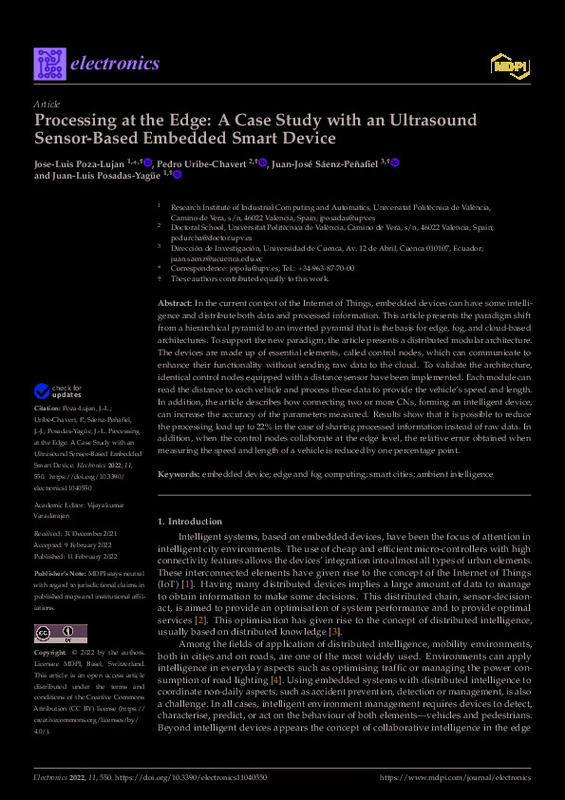JavaScript is disabled for your browser. Some features of this site may not work without it.
Buscar en RiuNet
Listar
Mi cuenta
Estadísticas
Ayuda RiuNet
Admin. UPV
Processing at the Edge: A Case Study with an Ultrasound Sensor-Based Embedded Smart Device
Mostrar el registro sencillo del ítem
Ficheros en el ítem
| dc.contributor.author | Poza-Lujan, Jose-Luis
|
es_ES |
| dc.contributor.author | Uribe-Chavert, Pedro
|
es_ES |
| dc.contributor.author | Sáenz-Peñafiel, Juan-José
|
es_ES |
| dc.contributor.author | Posadas-Yagüe, Juan-Luis
|
es_ES |
| dc.date.accessioned | 2023-10-24T18:01:17Z | |
| dc.date.available | 2023-10-24T18:01:17Z | |
| dc.date.issued | 2022-02 | es_ES |
| dc.identifier.uri | http://hdl.handle.net/10251/198746 | |
| dc.description.abstract | [EN] In the current context of the Internet of Things, embedded devices can have some intelligence and distribute both data and processed information. This article presents the paradigm shift from a hierarchical pyramid to an inverted pyramid that is the basis for edge, fog, and cloud-based architectures. To support the new paradigm, the article presents a distributed modular architecture. The devices are made up of essential elements, called control nodes, which can communicate to enhance their functionality without sending raw data to the cloud. To validate the architecture, identical control nodes equipped with a distance sensor have been implemented. Each module can read the distance to each vehicle and process these data to provide the vehicle's speed and length. In addition, the article describes how connecting two or more CNs, forming an intelligent device, can increase the accuracy of the parameters measured. Results show that it is possible to reduce the processing load up to 22% in the case of sharing processed information instead of raw data. In addition, when the control nodes collaborate at the edge level, the relative error obtained when measuring the speed and length of a vehicle is reduced by one percentage point. | es_ES |
| dc.description.sponsorship | This research was funded by the Spanish Science and Innovation Ministry MICINN: CICYT project PRECON-I4: "Predictable and dependable computer systems for Industry 4.0" TIN2017-86520-C3-1-R. | es_ES |
| dc.language | Inglés | es_ES |
| dc.publisher | MDPI AG | es_ES |
| dc.relation.ispartof | Electronics | es_ES |
| dc.rights | Reconocimiento (by) | es_ES |
| dc.subject | Embedded device | es_ES |
| dc.subject | Edge and fog computing | es_ES |
| dc.subject | Smart cities | es_ES |
| dc.subject | Ambient intelligence | es_ES |
| dc.subject.classification | ARQUITECTURA Y TECNOLOGIA DE COMPUTADORES | es_ES |
| dc.title | Processing at the Edge: A Case Study with an Ultrasound Sensor-Based Embedded Smart Device | es_ES |
| dc.type | Artículo | es_ES |
| dc.identifier.doi | 10.3390/electronics11040550 | es_ES |
| dc.relation.projectID | info:eu-repo/grantAgreement/AEI/Plan Estatal de Investigación Científica y Técnica y de Innovación 2013-2016/TIN2017-86520-C3-1-R/ES/SISTEMAS INFORMATICOS PREDECIBLES Y CONFIABLES PARA LA INDUSTRIA 4.0/ | es_ES |
| dc.rights.accessRights | Abierto | es_ES |
| dc.contributor.affiliation | Universitat Politècnica de València. Escola Tècnica Superior d'Enginyeria Informàtica | es_ES |
| dc.description.bibliographicCitation | Poza-Lujan, J.; Uribe-Chavert, P.; Sáenz-Peñafiel, J.; Posadas-Yagüe, J. (2022). Processing at the Edge: A Case Study with an Ultrasound Sensor-Based Embedded Smart Device. Electronics. 11(4):1-12. https://doi.org/10.3390/electronics11040550 | es_ES |
| dc.description.accrualMethod | S | es_ES |
| dc.relation.publisherversion | https://doi.org/10.3390/electronics11040550 | es_ES |
| dc.description.upvformatpinicio | 1 | es_ES |
| dc.description.upvformatpfin | 12 | es_ES |
| dc.type.version | info:eu-repo/semantics/publishedVersion | es_ES |
| dc.description.volume | 11 | es_ES |
| dc.description.issue | 4 | es_ES |
| dc.identifier.eissn | 2079-9292 | es_ES |
| dc.relation.pasarela | S\455192 | es_ES |
| dc.contributor.funder | AGENCIA ESTATAL DE INVESTIGACION | es_ES |
| dc.contributor.funder | Universitat Politècnica de València | es_ES |
| dc.subject.ods | 11.- Conseguir que las ciudades y los asentamientos humanos sean inclusivos, seguros, resilientes y sostenibles | es_ES |
| upv.costeAPC | 1136,16 | es_ES |








